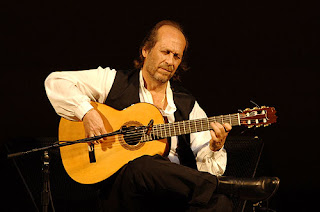 |
| Adela Campallo, bailaora |
Flamenco has four main elements:
1. Cante
 |
| Jose Valencia, cantaor |
This is the flamenco singing. In my experience, flamenco depends on the singing more than any other element. "One thing we can be sure of is that flamenco in its original form was only voice, a primitive cry or chant accompanied only by the rhythm which would be beaten out on the floor by a wooden staff or cane. These styles are known as Palo Secos and they are the oldest forms of song known today" (andalucia.com). There are dozens of palos or rhythms in flamenco and each one has a specific rhythm, guitar tones, lyrics, and sentiment.
These are the rhythmic hand claps that are part of the music. Nowadays, flamenco is often also accompanied rhythmically by a cajón which is a wooden percussive box that has its origins in South America. Jaleo, the shouts from performers and the audience also play a role in the rhythm and ambience of flamenco.
This is the dancing. It uses both intricate hand and arm movements which some historians believe can be traced to traditional Indian dancing, along with rhythmic foot patterns that can also be traced to India. The dance is traditionally improvised, relying on the communication between the dancer and musicians through his or her dance steps and the dancer's interpretation of the music. Nowadays, it is often more choreographed, however spontaneity remains important. "Spontaneous does not mean that a new dance be created every time the dancer takes the floor, but that the dancer will feel the music and dance what he feels for the music at that particular moment, expressing himself and letting his personality take grip of the dance, and not just going through the motions of a show that is rehearsed right down to the facial expressions" (andalucia.com).
4. Guitar
The guitar can be both an accompanying instrument in flamenco or a solo instrument. Many people are familiar with the music of Paco de Lucía, one of the greatest guitarists alive today. Flamenco guitar technique is distinct from all other genres of guitar. No pick is used, instead there are various ways the guitarist can use his nails to pluck and strum the strings.
 |
| Paco de Lucía, tocaor |
The guitar can be both an accompanying instrument in flamenco or a solo instrument. Many people are familiar with the music of Paco de Lucía, one of the greatest guitarists alive today. Flamenco guitar technique is distinct from all other genres of guitar. No pick is used, instead there are various ways the guitarist can use his nails to pluck and strum the strings.
An extremely brief and limited history of flamenco:
 |
| photo of a Cafe Cantante |
This barely scratches the surface of flamenco's rich history and complicated musical structure. There are many many many books and websites that go much much much further in detail. If you want to know more, go to flamenco-world.com, http://www.andalucia.com/flamenco/history.htm, just start googling, or go to the library. I can also recommend some good books about flamenco, so email me if you're interested!


No comments:
Post a Comment